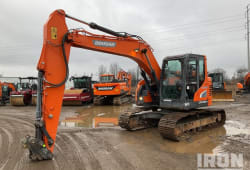Design-Build Construction: What It Is, How It Works, and Why It Matters
3 Min read
)
June 9, 2025
If you're planning a construction project and want a more efficient, streamlined experience, design-build construction could be the solution you need. Unlike traditional methods, design-build integrates both design and construction under one contract. This guide will walk you through the key elements of design-build construction, its benefits, how it compares to other methods, and how to get started.
What Is the Construction Design-Build Process?
The design-build process is a method of project delivery where a single entity-the design-build team-works under a single contract with the project owner to provide both design and construction services. Here's a step-by-step look at how it works:
Initial Consultation: The owner meets with the design-build firm to discuss goals, budget, and vision.
Conceptual Design & Budgeting: Preliminary drawings and cost estimates are developed early in the process.
Final Design & Documentation: Once the concept is approved, detailed construction plans and documentation are completed.
Construction Phase: With approvals in place, the construction team begins building, often overlapping with final design work to save time.
Project Completion: The firm handles finishing touches and handoff to the client.
This process eliminates the traditional gap between designers and builders, encouraging collaboration from the start.
Key Advantages of Design Build Construction Services
:format(webp))
Using design build construction services comes with numerous benefits:
Faster Delivery: Because design and construction phases can overlap, projects are often completed quicker than traditional methods.
Cost Savings: Early budgeting and collaboration reduce costly changes and budget overruns.
Streamlined Communication: A single point of contact simplifies decision-making and accountability.
Improved Quality: Coordinated teams result in more cohesive, efficient project execution.
Reduced Risk: Fewer disputes between design and construction teams mean lower legal and financial risks.
These advantages make design-build an attractive option for residential, commercial, and public projects.
Design-Build vs Design-Bid-Build: A Detailed Comparison
One of the most common questions is how design-build compares to design-bid-build, the traditional project delivery method.
While design-bid-build remains common, particularly in public sector work, design-build is rapidly growing in popularity for its ability to deliver better results with fewer headaches.
When to Choose Design-Build Construction
Not every project is suited for design-build, but it’s ideal for:
Projects with tight deadlines
Owners seeking a single point of accountability
Those wanting greater collaboration and innovation
Complex projects requiring fast, flexible execution
Design-build works well across a range of sectors, including healthcare, education, infrastructure, and residential construction.
How to Hire a Design-Build Construction Firm
Choosing the right partner is key to a successful project. Here’s what to look for:
Experience: Look for firms with a proven track record in design-build projects.
Team Integration: Strong collaboration between architects, engineers, and builders.
Licensing & Certifications: Ensure proper state licenses and affiliations with groups like DBIA (Design-Build Institute of America).
Client References: Ask for past project examples and client testimonials.
Transparency: A clear process, pricing structure, and open communication.
Asking the right questions and checking credentials can help you avoid costly missteps.
Conclusion
Design-build construction offers a modern, effective alternative to traditional construction methods. With faster timelines, cost savings, and better communication, it’s easy to see why more owners are choosing design-build. Whether you're starting a commercial development or building your dream home, the design-build approach can simplify your journey and deliver high-quality results.
Ready to start? Reach out to a qualified design-build firm and begin your project with confidence today!











